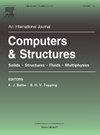随机激励下板壳高分辨率模态振型重建的逆有限元方法
IF 4.4
2区 工程技术
Q1 COMPUTER SCIENCE, INTERDISCIPLINARY APPLICATIONS
引用次数: 0
摘要
本文介绍了一种基于逆有限元法的板壳结构随机振动全场模态振型重建方法。所提出的方法,称为iFEM- more(模式重建),无缝集成经典iFEM与傅立叶变换使用韦尔奇的估计方法。通过处理动态应变测量,iFEM-MoRe可以提取整个结构的位移频谱,从而准确识别固有频率并高保真地重建全场模态振型。iFEM-MoRe专为2D和3D复杂结构拓扑设计,无需事先了解激励即可运行,使其成为现实操作环境中结构健康监测的强大且适应性强的工具。通过实验和数值研究验证了iFEM-MoRe的高精度。在实验分析中,利用表面传感器的离散应变数据对翼形复合材料板进行了形状重建和模态识别。数值分析了同一机翼在随机振动作用下的动力响应,验证了该方法的可靠性。对矩形板随机振动进行了研究,结果与有限元模态分析结果吻合较好。最后,通过对随机振动下弯曲板的分析,验证了框架对复杂几何形状的能力,并将结果与正模态解进行了比较。这些综合研究证实,iFEM-MoRe能够提供准确的模式识别和重建,为随机振动下具有挑战性的结构情况的全场动态分析建立了鲁棒性和通用性。本文章由计算机程序翻译,如有差异,请以英文原文为准。
Inverse finite element methodology for high-resolution mode shape reconstruction of plates and shells under random excitation
This study introduces a novel implementation of the inverse finite element method (iFEM) for full-field mode shape reconstruction of plate and shell structures under random vibration. The proposed methodology, termed iFEM-MoRe (Mode Reconstruction), seamlessly integrates classical iFEM with Fourier transformation using Welch’s estimation method. By processing dynamic strain measurements, iFEM-MoRe extracts the frequency spectrum of displacements across the structure, enabling accurate identification of natural frequencies and high-fidelity reconstruction of full-field mode shapes. Designed for both 2D and 3D complex structural topologies, iFEM-MoRe operates without prior knowledge of the excitation, making it a powerful and adaptable tool for structural health monitoring in real-world operational environments. The high accuracy of iFEM-MoRe is validated through experimental and numerical studies. In the experimental analysis, shape reconstruction and mode identification are performed on a wing-shaped composite plate using discrete strain data from surface-mounted sensors. Numerically, the dynamic response of the same wing under random vibration is analyzed, demonstrating the method’s reliability. A rectangular plate subjected to random vibration is also investigated, where iFEM-MoRe results show excellent agreement with finite element modal analysis. Finally, the framework’s capability for a complex geometry is validated through the analysis of a curved plate under random vibration, with results compared to forward modal solutions. These comprehensive studies confirm that iFEM-MoRe delivers accurate mode identification and reconstruction, establishing its robustness and versatility for full-field dynamic analysis of challenging structural cases under random vibration.
求助全文
通过发布文献求助,成功后即可免费获取论文全文。
去求助
来源期刊

Computers & Structures
工程技术-工程:土木
CiteScore
8.80
自引率
6.40%
发文量
122
审稿时长
33 days
期刊介绍:
Computers & Structures publishes advances in the development and use of computational methods for the solution of problems in engineering and the sciences. The range of appropriate contributions is wide, and includes papers on establishing appropriate mathematical models and their numerical solution in all areas of mechanics. The journal also includes articles that present a substantial review of a field in the topics of the journal.
 求助内容:
求助内容: 应助结果提醒方式:
应助结果提醒方式:


